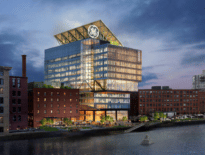
Spotify made headlines with a lease at Center Plaza, where a recent capital improvement project has retrofitted the outdated space to a modern workplace, complete with a Wired Certification confirming its connectivity capacity.
Today, we expect to be connected to the internet 24/7 – at home, during our commutes – we can even access the internet in-flight. Losing connectivity is frustrating in any of those situations, but it is mission-critical in the office. According to IDC, Fortune 1000 companies lose an average of $100,000 per hour of internet downtime. Given the risks, it’s no surprise that connectivity requirements are now integral to real estate strategy.
Boston is making great strides to provide best-in-class connectivity, and in 2017 it became the first city to partner with WiredScore to integrate technical principles of broadband-ready building design into the Article 80 review process for all new developments.
As the way we work continues to shift with the rise of intelligent building technology and collaborative digital tools, developers and architects will embrace “building from the internet up” and digital connectivity will become a cornerstone of branding and tenant retention. Amazon’s search for a HQ2 offered an unprecedented look into the real estate strategy of the world’s most influential companies and has perhaps been the most public example of this shift occurring within the industry.
Today’s companies want high-tech workspaces that fuel innovation, drive productivity and spark inspiration. Amazon’s detailed request for proposals for HQ2 included the need for strong digital infrastructure, including optimal fiber connectivity and multiple cellular phone coverage maps.
Although Amazon will not move into Long Island City as announced in 2018, the HQ2 process is evidence of a shift occurring in today’s real estate market: tenants are now dictating the real estate process more than ever before, and developers, landlords and cities must deliver spaces that accommodate specific companies’ priorities and styles of working to attract leading companies.
As we continue to watch the Amazon saga play out in the news, there is a lot more that we can learn about developing the next generation of best-in-class office product. HQ2 certainly isn’t the first, or last, prize to be won. Going forward, businesses are going to demand more from the cities where they are located and the developers they work with, especially when it comes to digital infrastructure. Many of Boston’s owners and developers have begun investing in connectivity and collaborating with tenants to build better workspaces.

David Miller
Redesigning Buildings for Tenants’ Needs
Boston Properties’ collaboration with Verizon at The Hub on Causeway is a recent example of the new dynamic between tenants and developers when creating the workspaces of tomorrow. Boston Properties worked hand-in-hand with Verizon to customize its space and revised design plans to meet its specifications. The notice of project change submitted to the Boston Planning & Development Agency cited changes to “satisfy current Boston class A office tenant demands for diverse amenities, smart and flexible workspaces, sustainability and connectivity.”
Businesses shouldn’t rule out existing office stock when looking for a space to meet their digital needs. Autodesk and Reebok have put down roots in the Seaport’s historic and Wired Certified Platinum Innovation and Design Building. Spotify made headlines with a lease at Center Plaza, where a recent capital improvement project has retrofitted the outdated space to a modern workplace, complete with a Wired Certification confirming its connectivity capacity.
Digital strategy has become more closely tied to tenant experience than ever before, and some owners are responding by leveraging intelligent building apps for tenant experience and operational efficiency. Millennium Partners, the firm behind Winthrop Square and one of the latest new developments to build to Platinum Wired Certification standards in Boston, has its own building software called ConnexIQ aimed at improving tenant experience through technology.
Tenant preferences and requirements are dictating the real estate process more than ever before, and developers, landlords and cities must respond by delivering space that serves the evolving needs of today’s businesses. Developers and owners that neglect to plan for necessary connectivity and technology risk falling out of step with their tenants needs and losing the battle for the next HQ2.
David Miller is head of WiredScore in Boston.





